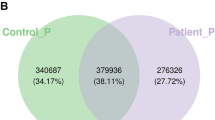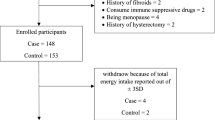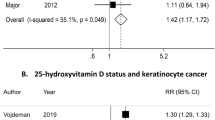Abstract
Background/objectives
To date, only two studies have investigated the relationship between vitamin D (vitD) deficiency and candidiasis in spite of vitD’s antimicrobial and immunomodulatory roles. We examined the relationship between sunlight exposure and consumption of vitD-rich foods, markers of vitD status, and vulvovaginal candidiasis (VVC) in an African population to add to the limited evidence and stimulate additional research.
Subjects/methods
Three hundred cases (females diagnosed as suffering from VVC) and three hundred controls (females diagnosed as suffering from any condition other than VVC) were selected from three health facilities in Cape Coast, Ghana. Sunlight exposure was assessed in a structured questionnaire with a food frequency questionnaire used to ascertain the frequency of consumption of vitD-rich foods.
Results
Self-reported low sunlight exposure was associated with 3.38 (95% CI:1.99, 5.74) increased odds of VVC. Low and moderate sunlight exposure estimated by outdoor visits was also associated with increased odds of VVC. In sensitivity analysis restricted to matched sunlight exposure data, low and moderate exposure was associated with 5.78 (95% CI: 2.57, 12.99) and 3.53 (95% CI: 1.85, 6.75) increased odds of VVC. Odds of VVC increased with decreasing levels of consumption of vitD-rich foods (Likelihood-ratio test trend p = 0.1382). In the joint analysis, low and moderate vitD intake was associated with much higher increased odds of VVC.
Conclusions
Our findings should be confirmed in prospective studies and clinical trials to strengthen the evidence base for preventive action and to also inform clinical decision making.
This is a preview of subscription content, access via your institution
Access options
Subscribe to this journal
Receive 12 print issues and online access
$259.00 per year
only $21.58 per issue
Buy this article
- Purchase on Springer Link
- Instant access to full article PDF
Prices may be subject to local taxes which are calculated during checkout
Similar content being viewed by others
Code availability
The Stata syntaxes for generating the results are available upon request from the corresponding author.
References
Holick MF. Sunlight and vitamin D for bone health and prevention of autoimmune diseases, cancers, and cardiovascular disease. Am J Clin Nutr. 2004;80:1678S–88S.
Nagpal S, Na S, Rathnachalam R. Noncalcemic actions of Vitamin D receptor ligands. J Endocr Rev. 2005;26:662–87.
Bartley J. Vitamin D: emerging roles in infection and immunity. Expert Rev Anti Infect Ther. 2010;8:1359–69.
Holick MF. Vitamin D deficiency. New Engl J Med. 2007;357:266–81.
Ahmad A, Khan AU. Prevalence of Candida species and potential risk factors for vulvovaginal candidiasis in Aligarh, India. Eur J Obstet Gynecol Repro Biol. 2009;144:68–71.
Mohanty S, Xess I, Hasan F, Kapil A, Mittal S, Tolosa JE. Prevalence and susceptibility to fluconazole of Candida species causing vulvovaginitis. Indian J Med Res. 2007;126:216–9.
Okonkwo NJ, Umeanaeto PU. Prevalence of vaginal candidiasis among pregnant women in Nnewi Town of Anambra State, Nigeria. Afr Res Rev. 2010;4:539–48.
Olowe O, Makanjuola O, Olowe R, Adekanle D. Prevalence of vulvovaginal candidiasis, trichomoniasis and bacterial vaginosis among pregnant women receiving antenatal care in Southwestern Nigeria. Eur J Microbiol Immunol. 2014;4:193–7.
Fidel PL. History and new insights into host defense against vaginal candidiasis. Trends Microbiol. 2004;12:220–7.
Sobel JD. Vulvovaginal candidiasis. Lancet. 2007;369:1961–71.
Apea-Kubi KA, Sakyi B, Yamaguchi S, Ofori-Adjei D. Bacterial vaginosis, Candida albicans and Trichomonas vaginalis infection in antenatal and gynaecological patients in Ghana. Trop J Obstet Gynaecol. 2006;22:108–12.
Aubyn GB, Tagoe DNA. Prevalence of vaginal infections and associated lifestyles of students in the University of Cape Coast, Ghana. Asian Pac J Trop Dis. 2013;3:267–70.
Apalata T, Longo-Mbenza B, Sturm A, Carr W, Moodley P. Factors associated with symptomatic vulvovaginal candidiasis: a study among women attending a primary healthcare clinic in Kwazulu-Natal, South Africa. Ann Med Health Sci Res. 2014;4:410–6.
Donders GG, Mertens I, Bellen G, Pelckmans S. Self-elimination of risk factors for recurrent vaginal candidiasis. Mycoses. 2011;541:39–45.
De Leon EM, Jacober SJ, Sobel JD, Foxman B. Prevalence and risk factors for vaginal Candida colonization in women with type 1 and type 2 diabetes. BMC Infect Dis. 2002;2:1.
Eckert L, Hawes S, Stevens C, Koutsky L, Eschenbach D, Holmes K. Vulvovaginal candidiasis: clinical manifestations, risk factors, management algorithm. Obstet Gynecol. 1998;925:757–65.
Mithal A, Wahl DA, Bonjour JP, Burckhardt P, Dawson-Hughes B, Eisman JA, et al. Global vitamin D status and determinants of hypovitaminosis D. Osteoporos Int. 2009;20:1807–20.
van Schoor NM, Lips P. Worldwide vitamin D status. Best Pr Res Clin Endocrinol Metab. 2011;25:671–80.
Wahl DA, Copper C, Ebeling PR, Eggersdorfer M, Hilger J, Hoffmann K, et al. Global representation of Vitamin D status in healthy populations. Arch Osteoporos. 2012;7:155–72.
Holick MF. The Vitamin D deficiency pandemic: approaches for diagnosis, treatment and prevention. Rev Endocr Metab Disord. 2017;18:153–65.
Linda AF, Asamoah S, William KBA, Edwin FL, Eddie-Williams O, Ebenezer KA, et al. Evaluating Vitamin D Status in Pre- and Postmenopausal Type 2 Diabetics and Its Association with Glucose Homeostasis. BioMed Res Int. 2018. https://doi.org/10.1155/2018/9369282.
Meddeb N, Sahli H, Chahed M, Abdelmoula J, Feki M, Salah H, et al. VitD deficiency in Tunisia. Osteoporos Int. 2005;16:180–3.
Feleke Y, Abdulkadir J, Mshana R, Mekbib TA, Brunvand L, Berg JP, et al. Low levels of serum calcidiol in an African population compared to a North European population. Eur J Endocrinol. 1999;141:358–60.
Prentice A. Vitamin D deficiency: a global perspective. Nutr Rev. 2018;66:153–64.
Okonofua FE, Calcium and vitD nutrition in Nigerian women and children. In: Thacher TD, editor. Nutritional rickets in Nigerian children: the way forward. Vevey, Switzerland: Nestle Nutrition; 2002. p. 17–21.
Lim JH, Ravikumar S, Wang YM, Thamboo TP, Ong L, Chen J, et al. Bimodal influence of vitamin D in host response to systemic candida infection - vitamin D dose matters. J Infect Dis. 2015;212:635–44.
Sroussi HY, Burke-Miller J, French AL, Adeyemi OM, Weber KM, Lu Y, et al. Association among vitamin D, oral candidiasis, and calprotectinemia in HIV. J Dent Res. 2012;91:666–70.
Gois PHF, Ferreira D, Olenski S, Seguro AC. Vitamin D and infectious diseases: simple bystander or contributing factor? Nutrients. 2017;9:E651. https://doi.org/10.3390/nu9070651.
Amegah AK, Nsoh M, Ashley-Amegah G, Anaman J. What factors influences dietary and non-dietary vitamin D intake among pregnant women in an African population. Nutr. 2018;50:36–44.
Millen AE, Bodnar LM. Vitamin D assessment in population-based studies: a review of theissues1– 4. Am J Clin Nutr. 2008;87:1102–5.
Brot C, Vestergaard P, Kolthoff N, Gram J, Hermann AP, Sørensen OH. Vitamin D status and its adequacy in healthy Danish perimenopausal women: relationships to dietary intake, sun exposure and serum parathyroid hormone. Br J Nutr. 2001;86:97–103.
van der Mei IA, Blizzard L, Ponsonby AL, Dwyer T. Validity and reliability of adult recall of past sun exposure in a case-control study of multiple sclerosis. Cancer Epidemiol Biomark Prev. 2006;15:1538–44.
McCarty CA. Sunlight exposure assessment: can we accurately assess vitamin D exposure from sunlight questionnaires? Am J Clin Nutr. 2008;87:1097S–1101S.
Hu FB, Willet WC. Current and future landscape of nutritional epidemiologic research. JAMA. 2018;320:2073–4.
Bärebring L, Amberntsson A, Winkvist A, Augustin H. Validation of dietary vitamin D intake from two food frequency questionnaires, using food records and the biomarker 25-hydroxyvitamin D among pregnant women. Nutrients. 2018;10:E745. https://doi.org/10.3390/nu10060745.
Weir RR, Carson EL, Mulhern MS, Laird E, Healy M, Pourshahidi LK. Validation of a food frequency questionnaire to determine vitamin D intakes using the method of triads. J Hum Nutr Diet. 2016;29:255–61.
Van Dam RM, Hunter D. Biochemical indicators of dietary intake. In: Willett WC, editor. Nutritional epidemiology. 3rd ed. New York, NY: Oxford University Press; 2012. p. 150–212.
Bingham SA. Biomarkers in nutritional epidemiology. Public Health Nutr. 2002;5(6A):821–7.
Yuan C, Spiegelman D, Rimm EB, Rosner BA, Stampfer MJ, Barnett J, et al. Relative validity of nutrient intakes assessed by questionnaire, 24-hour recalls, and diet records as compared with urinary recovery and plasma concentration biomarkers: findings for women. Am J Epidemiol. 2018;187:1051–63.
Liu PT, Stenger S, Li H, Wenzel L, Tan BH, Krutzik SR, et al. Toll-like receptor triggering of a vitamin D mediated human antimicrobial response. Science. 2006;311:1770–3.
Chesney RW. Vitamin D and the magic mountain: the anti-infectious role of the vitamin. J Pediatr. 2010;156:698–703.
Walker VP, Modlin RL. The vitamin D connection to pediatric infections and immune function. Pediatr Res. 2009;65:106R–113R.
Misawa Y, Baba A, Ito S, Tanaka M, Shiohara M. Vitamin D(3) induces expression of human cathelicidin antimicrobial peptide 18 in newborns. Int J Hematol. 2009;90:561–70.
Jeng L, Yamshchikov AV, Judd SE, Blumberg HM, Martin GS, Ziegler TR, et al. Alterations in vitamin D status and anti-microbial peptide levels in patients in the intensive care unit with sepsis. J Transl Med. 2009;7:28.
Gow NA, van de Veerdonk FL, Brown AJ, Netea MG. Candida albicans morphogenesis and host defence: discriminating invasion from colonization. Nat Rev Microbiol. 2011;10:112–22.
Acknowledgements
The authors will like to thank all the patients who agreed to participate in this work. No funding was received for this work. AKA conceived and designed the study, analyzed the data and contributed to the writing of the paper. FKB, AA, and EAF collected the data with FKB contributing to the writing of the paper. CLW reviewed drafts for important intellectual content. All authors approved the final submitted manuscript.
Author information
Authors and Affiliations
Corresponding author
Ethics declarations
Conflict of interest
The authors declare that they have no conflict of interest.
Additional information
Publisher’s note Springer Nature remains neutral with regard to jurisdictional claims in published maps and institutional affiliations.
Rights and permissions
About this article
Cite this article
Amegah, A.K., Baffour, F.K., Appiah, A. et al. Sunlight exposure, consumption of vitamin D-rich foods and vulvovaginal candidiasis in an African population: a prevalence case–control study. Eur J Clin Nutr 74, 518–526 (2020). https://doi.org/10.1038/s41430-019-0517-7
Received:
Revised:
Accepted:
Published:
Issue Date:
DOI: https://doi.org/10.1038/s41430-019-0517-7



